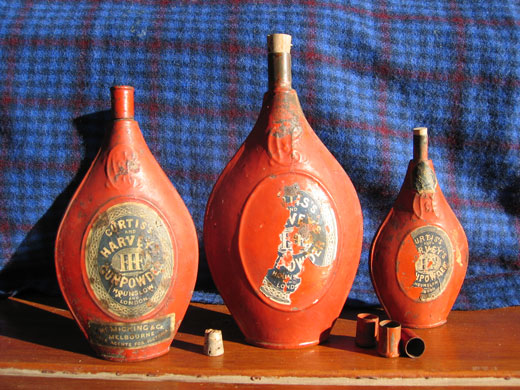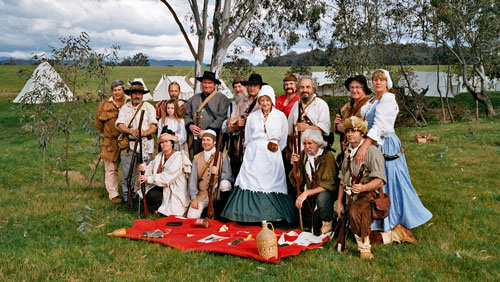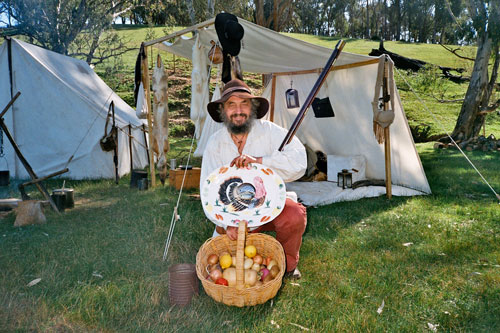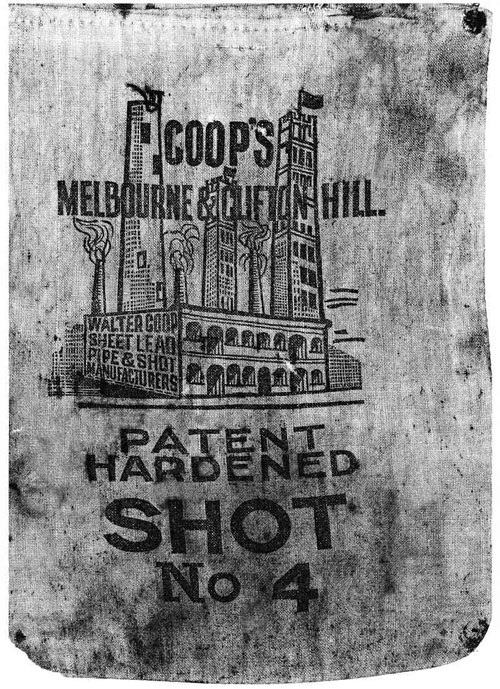Vol. 13, October 2008
 Favourite photos – Our cover girl is Jan Convey – seen here concentrating on her bead work.
Favourite photos – Our cover girl is Jan Convey – seen here concentrating on her bead work.Warm spring greetings to all… This will be our last Newsletter for calendar 2008 and we hope you find it both informative and entertaining. Please enjoy the read! We have pleasure in featuring pretty Jan Convey, seen here dressed in her best buckskins, and enjoying spring rendezvous camping. Thanks to Jan for sharing this super photograph. We wish all readers a safe, happy summer and good trappings over Xmas / New Year.
Collectables are the theme of this edition, but first there is a heritage event to be celebrated – before it’s completely forgotten – Guy Fawkes Day! Also remembered as Cracker Night – when we gathered to celebrate our parliament with fireworks and fun.
Parliament! Home of the politicians’ hell bent on obliterating this major Anglo-Saxon heritage festival from the Australian calendar, while seemingly supporting all other ethnic festivities, and boasting we are a multi-cultural society? John Williamson wrote and recorded a brilliant song about Cracker Night, and occasionally, obscure news columns have lamented the passing of the Guy Fawkes traditions. We’ve been double crossed by the same folks we elected, for you can buy fireworks in the ACT, so I’m told. Better make sure you get a “permit” before you light blue touch paper. Bunkum!
Please to remember,
The fifth of November,
Gunpowder treason and plot.
We know no reason,
Why gunpowder treason,
Should ever be forgot.
Opening a can of History
Dad smoked tobacco! It was inevitable that I would start collecting cigarette cards and those educational match box labels. I’d paste them into an album of sorts. His empty tobacco tins were handy storage containers for spare labels to swap with school mates. Didn’t every boy keep a folding knife and a tobacco tin of treasures in his pocket? Always hungry after school, my Grandma’s biscuit tin demanded attention, and the groundwork for a life-long interest in sheet metal containers was firmly laid.
Years later, I gained employment in a biscuit factory, in an era when biscuits were still sold in large returnable tins designed as store keeper’s bins. The grocer would weigh out a few ounces to sell repacked loose in a brown paper bag. The tins attracted a deposit to ensure their return to the supplying company – for washing, relabelling and re-use. The labels were works of art in themselves, designed to attract more sales, of course. Throwaway packaging has long replaced the tins, which are now collector items, as people cling fondly to solid familiar comforts, in our rapidly changing world.
Reversing change and learning old ways can be great fun. Turning back my shooting time clock and discovering black powder, I rekindled a former interest and passion for old tins. Black powder was, and still is, supplied in tins, although the soulless plastic jar has apparently dealt a death blow to any tin vessels from European sources.
My first black powder purchase was a can of Goex FFg. It appeared to be the only brand available back then, although several blokes at the old Seymour club range had some older cans of Curtis’s & Harvey’s powder. After the shoot they were happy enough to part with emptied tins and suddenly I’d become a collector. The fun didn’t end with the last grains of powder being shot off, because a new interest was growing.
Browsing in gun shops was another favourite pastime, always hopeful of spotting a tin of unusual historic label, gathering dust and stored out of sight, unloved and forgotten. Guess you could say I was hooked – to such an extent I even started to buy empty black powder tins, just for the labels. I had discovered older cans of differing shape and size, all painted a deep Prussian blue, and some even older tins painted bright orange, but of an elegant oval shape, similar to commercial copper measuring flasks.
Whilst writing this article, and with the dollar advantage of favourable exchange rates, I ordered some books from the States. Gun Powder Cans & Kegs by T&D Bacyk and T Rowe had been on my wanted list far too long. The book is a Collectors bible, an absolute gem, focusing on major American manufacturers. Unfortunately, these U.S. cans are rare here in Australia. Colonial shipping trade dictated that our black powder needs mostly came from the U.K. – produced at the Curtis & Harvey Hounslow mills.
The C&H flask-tins in our photograph are over 100 years old. The ½ lb size is the more common, but a larger 1lb and a diminutive ¼ lb tin were also marketed. The labels on these older tins are usually well-worn and tattered, or missing altogether, as their bellied shape leads to rubbing, wear and tear. The tins were often carried in the shooting pouch or coat pocket – serving as poor man’s powder flasks. Those labels still readable all denote FFF grade; Bacyk and Rowe suggest this is because the finer grades used in smaller calibres were not used up and thrown away, “so the can was put on the barn rafter or in an attic and forgotten”. Or is there some other explanation?
The black powder contents were sealed by a small cork and a sleeved tin lid. This lid could be used as both powder measure and shot measure, and is frequently missing in found samples. A C&H logo is embossed at the shoulder on both sides, and the can is constructed with two identical shell-like halves with folded soldered seam, a top spout and a rather small, unstable base, otherwise, formed rather like standard copper flasks.

Collectables
Sadly, the hydroscopic nature of black powder hastens the onset of rust to the metal, and foxing to the labels. Tins in average to better condition are nice collector items. Like the ½ lb can on the left, which has an added Australiana feature. Note the lower factory label which reads – McMicking & Co. Melbourne, Sole Agents for Victoria.
McMicking & Co. were hardware merchants located at 43 Elizabeth St., Melbourne. They are listed in Wise’s Post Office directory Victoria 1888-89, as sole agents for both Curtis’s & Harvey’s London, and Kames’ Gunpowder Co. London. Later entries show them as moved to 381 Little Collins Street.
The C&H powder mill on the River Crane at Hounslow (some 7 miles from London) started life as a medieval corn mill. Then in 1766, Edmund Hill converted it to become a profitable gunpowder mill. He’d retired a millionaire by 1800. Curtis and Harvey acquired the powder mill in 1820, expanding the site and the number of mills. The mills with associated buildings and bunkers eventually covered over 100 acres, suitably buffered with earth mounds and treed thickets for safety. However it is recorded that the Hounslow mills experienced at least 55 significant explosions during their operating period, and may have suffered many smaller undocumented explosions.
In 1898 C&H became a limited company and 20 years later (1918) merged to form a new company Explosive Trades Ltd. Two years later Nobel took control, followed by Imperial Chemical Industries Ltd in 1926. FFF is a registered trademark of ICI who continued to market the C&H brand, transferring production to other mills in the UK, and later to Germany, but manufacture of all gunpowder at Hounslow ceased in 1927.
We hold in our hand a strong link with history, and more than just a little nostalgia, when we examine these old tins.
Chook
Spring Buffler Shoot and Rondyvoo
Our traditional September Rendezvous held during the first week of gazetted school holidays turned on some mighty fine weather. Cool pleasant evenings at campfires contrasted with warmer afternoons consistently topping 28 C., when the shade along the picturesque Beaver Creek enticed lazing about in harmonious company of good friends and nature both.
Most pilgrims had arrived and set up camps by Friday afternoon to ensure a full weekend of fun. Some eye-opener shooting was in order early Saturday morning; that is, after the customary rush at the Trade Blankets. The best goodies always get snapped up quickly! Dick and Susan Schwer from Adelaide visited for the day’s fun.
Later in the morning a special trade blanket was laid out for all to see. It displayed many little treasures, donated to the Club by John and Elke Suardi of the Shooters Shack at Rosewhite. All items were sold in a no-holds-barred frenzied auction where a wink, or blink, or scratch of the nose was considered the next highest bid. The tally at the last hammer fall amounted to $75.00, a very welcome boost to the Club piggy bank. Our grateful thanks to John and Elke for their kind gesture.
During the afternoon we held a Skill ‘n Luck blanket shoot. Contestants shot at a simple playing card – a not too difficult target – at roughly 25 yards (by my measure). Those equalling the highest number of scoring shots then had to resort to luck at the turn of the card, with the higher face value card winning.
First pick off the blanket went to teen brave Indiana. And brave she was to compete with primitive bow and arrows against some skilled Longhunters’ with fine rifles. Club President, Ian earned second pick, but hang on, he always touts there can be no second or third at Primitive shoots. Actually, blanket shoots are really fun, and especially so, if a little Lady Luck is added to spice the match. And – everybody wins!
Following on after our Annual General Meeting, Saturday night’s feast was supposed to be prepared and cooked up by the blokes, but we suspect some Trappers bribed their brides. Whatever, there was more than an elegant sufficiency to go around the entire camp and supply Sunday breakfasts as well. Pumpkin soup or Pea and Ham, take your pick, or try both, followed by Pot roasts, spit roasts, beef, venison or rabbit stews – just to mention a portion of the wonderful cuisine.
Sundays are always special in camp, and Ian and Murray had certainly arranged a challenge for rifle or smoothbore in our Mountain Man Hunt shoot. Entry fee was just one or two vegetables into a basket. Then, following the lush green banks of Beaver Creek, each contestant had to seek out hidden game targets. Only one shot was allowed at each and a flash-in-the-pan was counted as lost game. The event was timed, and scored on targets observed, targets hit, and the ability to make fire at the close.
Richard turned out the winning performance, and was awarded a Turkey plate and the basket full of harvest vegetables, fruit and eggs. See our congratulatory photo and the group shot of participants happy to share Richard’s success.
Monday had a couple of Trappers breaking camp, heading for different pastures, while others just concerned with plinking or loafing. A rather unusual red dust storm manifested during the afternoon, creating an eerie atmosphere of low visibility, and bringing strong gusty winds carrying good overnight rains. The morning dawned clear and fine, as did the remainder of a warm balmy week.
Those staying the full week busied themselves relaxing and enjoying easy times. A second Mountain Man Hunt was organised, with game targets secreted in the shadows by the tricky wives. At about this time Kevin observed the level of his grog barrel sinking suspiciously. A trap was set and a certain rat was caught in that trap. Old Rattus was duly hanged, then as an after-thought – given a fair trial? We’re having fun!
Richard and Kevin went out with their Primitive bows, saw only a large Black snake, yet still had fun loosing a few arrows at imaginary beaver. Rolly and Jo were regular visitors of an evening when the moonshine glowed on each face around the camp fires. Evening meals were more like lavish feasts, and it was indeed a pleasure and honour to be invited out to dine at various camps. None of those tough old trapper boots or cooked saddle leather “wasting” diets. We’re having fun and dining like Lords too!
The youngsters in camp were continually doing what all kids do when camping – from dawn until well after dark; Playing near the creek, playing near the campfires, playing getting dirty. Both William and John asked 100s of questions each day, and that’s the job of all kids, and the easiest way to learn. We are one big extended family!
Camp numbers swelled again for the closing weekend, with the workers returning to their tents. Jeff and Katherine arrived to set up a small voyager tent; with a plunder laden trade blanket causing another stampede. They were in company of sweethearts John and Sarah from Sydney. Katherine is expecting her first babe soon, so our family of Trappers grows again. Oh, Sydney folk are alright – Really! Actually we may just entice John and Sarah to come south of the big river. Hope so!
It was another weekend of smoking flintlocks, fishing, not so much knife and hawk, but lots and lots of fun, before, sadly, it was time to start decamping and say goodbyes. See lots more photos on our website Events page.
Shot (Framed and Hung)
Pride of place on the wall of our President’s workshop-den is a remnant of Victorian history. Salvaged for its memorabilia interest, and nicely framed behind glass, hangs a small calico bag about 8 by 10 inches. The inked label tells us that the bag once contained lead shot produced at the Clifton Hill shot tower owned by the Coop family.
Far better known is Coop’s 50 metre tall shot tower, built in 1890, and enclosed in Melbourne Central’s steel and glass dome in 1991. Walter Coop demolished several small dwellings to make way for this square-sided tower, and four generations of Coops produced shot and various other lead products there until 1960.
Both the Clifton Hill and Melbourne Central shot towers are Heritage listed. However a third shot tower and Melbourne’s first, was built by Louis Hamel in Sackville St. Collingwood in 1878, and has long since been demolished. Interestingly, Ian’s framed calico bag depicts all three shot towers as background to the labelling.
Richard Hodgson erected the round tower at Clifton Hill in 1882. It is the world’s tallest brick shot tower at 77.6 metres, and it remains the tallest brick structure ever built in Australia. The base diameter is 7m and it has a 4m top level. Walter Coop bought Hodgson’s tower and surrounding works in 1896.The Coop family retained ownership until 1986, although production had ceased at Clifton Hill in 1947.
Referring just to the Melbourne Central tower, Heritage Victoria records – “Shooting was a popular pastime – six tons of shot a week was produced in this shot tower alone – and used in shooting for food, for sport and for defence.” Wow!
I know most of us like to hunt and shoot for our meat, and we all love to shoot for sport, and I’m still defending several acres against rabbit invasion – but together we shoot merely a few pounds of shot. Six ton a week seems a heritage well and truly lost!
Now for a serious final cautionary note – Ian originally had two of these little Coop’s shot bags, in somewhat grubby condition, but even the gentlest washing obliterated the ink signage on one. Be very careful handling our heritage – and guard it well.
Club Committee 2008 – 2009
President – Ian Convey, tel. 03 5367 8450
Vice Pres – Bob Ellis, tel. 03 5796 2753
Secretary – John Fowler, tel. 03 5753 4455 Email chookster@vfowler.com
Treasurer – Murray Convey, tel. 03 5346 1086
Committee – Kevin Norris, tel. 03 5753 4415
Committee – Jim Walker, tel. 03 9723 5868
Contributing articles welcomed. All correspondence and enquiries to the Secretary, 252 Pini Lane, Mudgegonga 3737. Email chookster@vfowler.com Tel. 03 5753 4455.




